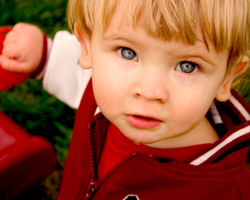 Children learn to think and be creative through artistic expression. Art is play and play is art. This kind of play enriches children’s sensory and aesthetic appreciation.
Children learn to think and be creative through artistic expression. Art is play and play is art. This kind of play enriches children’s sensory and aesthetic appreciation.
Art also becomes a means for children to talk about their thoughts and to share with others. Children who are angry, upset, fearful or sad provide us with clues through the images they draw, the colors they choose and, of course, their labeling of the images. As language skills grow and children learn to write, they often use pictures to illustrate their thoughts.
Children’s earliest creative efforts often are labeled “scribbles” because they are a combination of pictures and words as they begin to use their fine motor skills to leave marks on surfaces. This is a natural and desirable part of early childhood development. Rather than finding a child’s earliest artistic expressions on your walls or furniture, it is important to provide paper or another appropriate smooth surface that allows them to leave their mark safely!
How can we, as parents, help our children enhance their creativity? First, it is important to remember that artistic expression is very personal. A child whose work is criticized may feel badly and decide to stop creating altogether. Rather than trying to “fix” a child’s artwork or coach them to do it differently, the experience can be more enjoyable for parent and child if the child is provided with an image or idea and allowed to recreate in his or her own way.
As parents, we can admire our children’s work by commenting on something in the picture that is most appealing to us. An enthusiastic comment such as, “I like your tree so much!” is the ideal way to show your child how much you appreciate her work. If you are unsure about what it is your child has created, a simple statement such as, “I like this! Can you tell me about it?” will avoid hurt feelings and allow him to share with you.
Appropriate art materials for a two-year-old include watercolors, glue, chalk, markers, crayons, paper, clay or playdough and safety scissors. There are many coloring books available for parents to select for their children. Yet, isn’t it much more wonderful to provide a blank sheet of paper and allow a child to create her own picture? When she completes her masterpiece and you write her name and age on the paper, you’re showing her how much you value her art.
Better yet, show your child how much you like to draw and paint. Play beautiful music while you create your works of art side-by-side. Talk about lights and darks, curves and straight lines, circles and squiggles. Who knows? You may be inspiring her to become a great artist someday!
